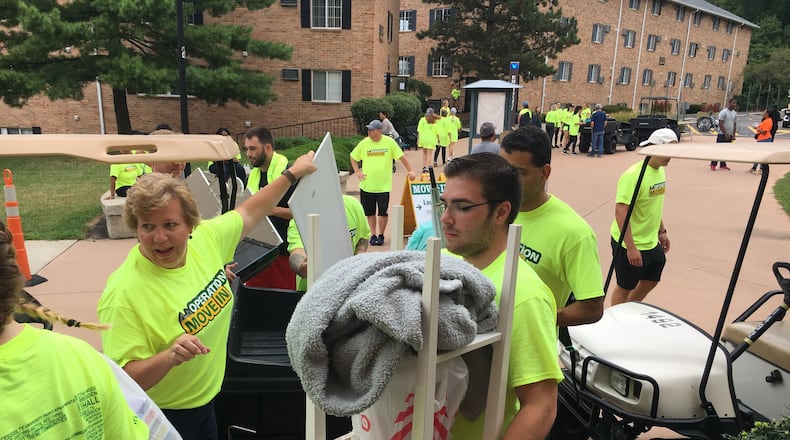2018 STORY: Math ACT scores in U.S. lowest in 20 years
State, university and local K-12 officials have been working for years to get more students to “remediation-free” status, because those developmental-level college courses cost students money but don’t count towards a degree. Ohio Higher Ed officials say the courses “are known to be a barrier … reducing the likelihood that students complete a certificate or degree.”
Why results changed
The big decline in Ohio’s remediation rate earlier this decade had much to do with a new set of goalposts, as the state set uniform “remediation-free” standards for all public universities that were lower than some schools’ previous bar. By those standards, students who meet certain scores on college entrance exams — for the ACT, 18 in English, 22 in reading and math — are deemed remediation-free.
But the student remediation rate has continued to shrink since then.
“There really are too many variables involved to speculate on what exactly has contributed to the continued decline in the remediation rate,” Ohio Higher Ed spokesman Jeff Robinson said, pointing to efforts in placement, advising, bridge programs, and other strategies. “But it is certainly a collaborative effort and the result of caring faculty and staff working together.”
RELATED: Photos, bios of local schools’ 2019 valedictorians
John McNay, Ohio president of the American Association of University Professors, said his group would like to see more study of how many students actually need remediation and why.
“It remains to be seen whether there has been real improvement in college readiness or simply some gimmicky addressing of the problem,” said McNay, professor of history at the University of Cincinnati - Blue Ash.
Ohio students’ performance on the ACT exam in recent years has been flat to declining, not matching the improvement in remediation rates. From 2014-17, Ohio students’ composite score on the ACT remained flat at 22.0 each of those four years, and there were very slight decreases in math (21.7 to 21.6) and English (21.4 to 21.2).
McNay said when remedial English and math sections were eliminated at many colleges, students who previously would have been placed there were put in the smallest, most intensive sections of introductory courses instead. He said he’d like to see data on course- and degree-completion for those students.
EDUCATION: Ohio legislator explains school funding plan
Robinson said within Ohio’s remediation-free standards, the cut score for Accuplacer English test was reduced for the Class of 2018, making it slightly easier for some students to score remediation-free.
“The new cut score was in closer agreement with the scores other colleges nationally were using for placement and would be a more reasonable predictor of success,” Robinson said.
Local schools’ stats
The report also shows a remediation rate for each high school in the state that had at least six students enroll at an Ohio public college. These rates are not a clear proxy for a high school’s academic performance, as they don’t measure the academics of students who attend private colleges, out-of-state colleges or no college.
Cedarville High School and The Miami Valley School, both with less than 20 freshmen at Ohio public colleges, were the only two schools locally where no students needed remediation. Dixie, Troy Christian, Oakwood and Carlisle were among the schools with rates under 10%.
Some of the largest suburban schools had remediation rates between 11 and 16%, including Fairmont, Centerville, Beavercreek and Lebanon, along with the Carroll and Alter Catholic high schools.
RELATED: State touts schools’ rise; former leader doubts data
The highest rates locally were 67% at the Horizon Science Academy charter school and 56% at Middletown Christian, followed by Dayton Meadowdale (41%), Northridge (41%) and Trotwood-Madison (39%).
Ohio Higher Ed officials pointed out that remediation is correlated with wealth and poverty, just as state test scores are. A higher percentage of economically disadvantaged students had to take remedial courses.
Strategies for students
Liz Jensen, career tech principal at Kettering’s Fairmont High School, said the school is taking multiple steps, both within classroom instruction and outside of it, to make sure students are well-prepared for college. Students in 8th to 11th grade take a pre-ACT exam once a year, with teachers and families given data on whether the students are on-track to be remediation-free. They’re also working on motivation.
“We made a video — why I care about the ACT,” Jensen said. “We have an NCAA athlete on there and a kid who has tested out of multiple levels at Sinclair to save a lot of money,” Jensen said. “We have a kid who’s just trying to be remediation-free, and we have a kid who’s trying to get into Ivy League schools.”
For Dayton Public Schools, the state report shows the number of students attending Ohio public universities is low, but some individual high schools’ remediation rates mirror the state average, with Dunbar (28%) just above it and Thurgood Marshall (24%) just below it.
RELATED: Panel offers changes for state report card structure
Superintendent Elizabeth Lolli said she hopes the district’s new college-career coordinator will help more students secure scholarships and attend college. College-career classes are mandatory for DPS high school students, and a new Road to College initiative gives seventh-graders older student mentors to help them stay on track.
“We continue to increase the rigor and expectations in our classrooms, but that change comes more slowly,” Lolli said
Jensen said the state’s College Credit Plus program has helped motivate more students as well. Students have to show college readiness in order to participate and earn the free college credits while still in high school.
“I’m very proud of the district — though addressing college remediation, we are addressing academics in general,” Jensen said. “We’re (building) a student that is prepared to go through any pathway. We have acknowledged that not every kid is going to a four-year or two-year college, but we should prepare you if you want to do that.”
About the Author

